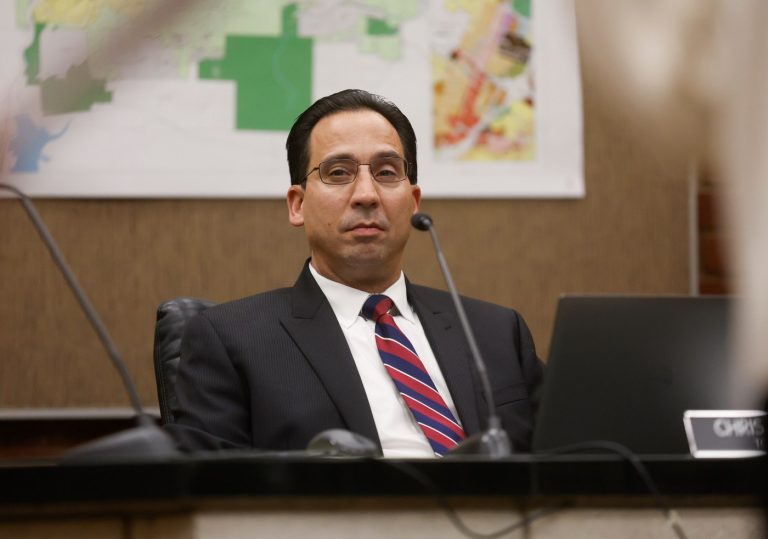A species of small, furry owls who nest underground in open fields are in imminent danger of extinction and may get a lifeline extended from the California Fish and Game Commission.
A petition to list the western burrowing owls as an endangered or threatened species was accepted on Oct. 10 by the commission, making the unusual owl a “candidate” for protective status under the California Endangered Species Act.
“This is really good news. I’ve been working personally on this for 20 years. Burrowing owls don’t have a lot of time left. We are going to do everything we can to get them listed,” said Jeff Miller, senior conservation advocate with the Center for Biological Diversity, on Oct. 11.
Miller wrote the petition on behalf of the center as well as Defenders of Wildlife, Burrowing Owl Preservation Society, Santa Clara Valley Audubon Society, Urban Bird Foundation, Central Valley Bird Club and San Bernardino Valley Audubon Society.
RELATED: Giving a hoot: How to protect owls in your backyard
As a candidate, the burrowing owls will be protected during a status review being conducted by the California Department of Fish and Wildlife. The review will last between 12 and 18 months, said Miller. After the review is complete, the commission will vote on listing the owls as endangered — the highest level of protection — or threatened, a step down.
“Burrowing owls have dwindled and vanished at an alarming rate around the state as their homes are bulldozed for irresponsible sprawl development,” Miller said.
Burrowing owls, known scientifically as Athene cunicularia hypugaeaare, are the only owl species that nest and roost underground. In the early 1900s, they nested across Southern California. But they’ve suffered significant losses due to development, conversion of grasslands to agricultural uses and large-scale wind and solar energy projects, according to environmental groups. Owls are also killed by wind turbines and vehicles, and by ingesting rodenticides, according to environmental groups.
These owls have vanished from 19 of the 51 California counties they once inhabited, the Center for Biological Diversity reported. Only 225 breeding pairs are left in the central-western and southwestern California regions, the group reported.
Burrowing owls have a round head, white eyebrows, yellow eyes and a prominent oval face. They are about 7-10 inches tall. They have long, stilt-like legs and a stubby tail.
The majority in Southern California are found in southwestern San Bernardino and western Riverside counties. They are extinct from Orange and Ventura counties, and most of Los Angeles County, according to the petition.
Having interim candidate status means the species will get the same protections as if they were listed as a state threatened or endangered species, Miller explained. “No one can kill or harm them and developers will need a permit from the Department of Fish and Wildlife,” he said.
RELATED: Rats? California communities are swapping poison for owls
However, the interim protections can be interpreted in many ways, leaving the bird’s protection up in the air.
Miller said his group will try to stop the practice of allowing owls to be evicted from nests. Under state policy developers can collapse the burrows — usually holes built by ground squirrels — once the owls have left the nest after breeding season. But Miller said the birds come back to the same nests time and time again.
If the burrows are gone, the owls’ success at breeding diminishes, he said.
Burrowing owls once found in empty fields just east of Ontario International Airport have been diminishing for years due to the growth of warehouses. A plan to build more warehouses on the site east of Haven Avenue was approved on March 21, 2023 by the Ontario City Council, which also denied an appeal. Construction is ongoing, said Suzanne Thompson, chair of the Pomona Valley Audubon Society’s Burrowing Owl Committee.
Two pairs of owls were moved to a rehabilitation site, she said. They may survive if they become accustomed to their new habitat and start breeding. About six or seven pairs remained on the site, she said.
“It is grim for those particular owls at the (airport) site. It is totally grim,” she said. The Ontario Airport did not respond to an email sent on Monday, Oct. 14.
A better fate awaits burrowing owls living on a large field near the Chaffey College satellite campus in Chino, set aside in a mitigation agreement for the College Park development, Thompson said. “It is a wonderful place for burrowing owls,” she added.
Using people to keep tabs on the little, furry birds at the 70-acre field site, the group believes there are about eight pairs of nesting owls that have raised their young this past summer, Thompson said.
“The owls have lived there for quite awhile. We started monitoring them in 2017,” she noted.
In February 2021, photos of the birds were sent to Pomona-born astronaut Victor Glover at the International Space Station by a former biology teacher from Ontario High School which Glover attended. Glover said later the preservation of rare owls fit well with his experiments involving climate change on Earth.
Burrowing owls have also been spotted at Chino Airport, in the dairy farms of Chino and at the North Etiwanda Preserve in Rancho Cucamonga, Thompson said.
In western Los Angeles County, the birds no longer exist, the petition stated. However, some owls have been found in the north county region in the Antelope Valley where a small number of breeding owls have persisted, according to the petition.
About 560 pairs were found in the western Mojave Desert and 179 pairs in agricultural areas of the Palo Verde Valley in 2007, the petition stated.
The rare bird once was abundant in L.A. County according to a 1912 census. They continued to be spotted at Playa del Rey, Hermosa Beach and Cal State Long Beach until the 1980s. They are no longer found in these areas, according to the petition.












